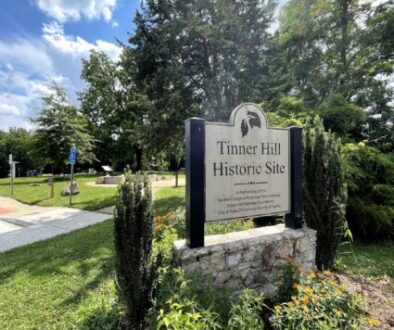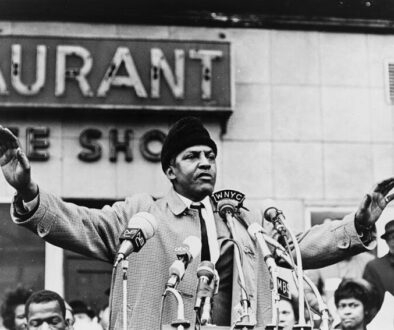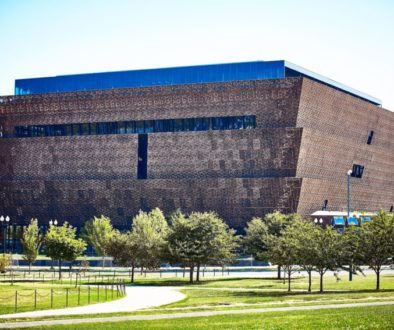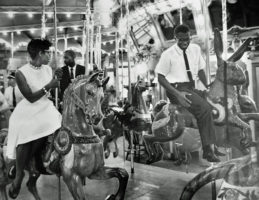
Not all civil rights battles were fought in marches or at lunch counters. In the Washington, D.C. area, one struggle occurred at Glen Echo amusement park, and another took place down the road at Gwynn Oak amusement park.
The protests show the pervasive reach of segregation, and the many places people had to fight for equality.
Glen Echo, now part of the federal George Washington Memorial Parkway, provides a fascinating look at a sit-in on a carousel. The summer long 1960 protest, led by a Howard University coalition cleverly called NAG (Non-violent Student Action Group), was met with menacing counter demonstrations from the American Nazi Party.
Less than an hour away a similar protest would follow three years later at Gwynn Oak amusement park in Baltimore – and that one had a surprising link to the March on Washington.
A carousel might seem a superfluous place to protest when compared to locations like schools and public services, but Martin Luther King Jr. thought otherwise.
In his famed “Letter from Birmingham Jail” he wrote:
“.. you suddenly find your tongue twisted and your speech stammering as you seek to explain to your six year old daughter why she can’t go to the public amusement park that has just been advertised on television, and see tears welling up in her eyes when she is told that Funtown is closed to colored children, and see ominous clouds of inferiority beginning to form in her little mental sky, and see her beginning to distort her personality by developing an unconscious bitterness.”
Glen Echo amusement park
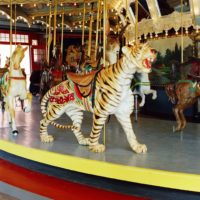
The privately owned Glen Echo amusement park dates to the early 20th century. From the beginning, African-Americans weren’t allowed. By the 1950s, it served white public school students in Montgomery County, Maryland, who were able to use its swimming pool, while Black public school students were bused to pools in Washington. The park also was served by a trolley land leased from the federal government.
Both made it a fertile ground for protest, which was inspired by the sit-ins in Greensboro, North Carolina, which had started earlier in 1960, and set off demonstrations across the country.
On June 30, a group of D.C.-area students arrived at the park and attempted to enter. When they were turned away, several ran to the carousel, where they were arrested. Pickets and protests lasted throughout the summer.
Picket signs made the simple argument: “If we work here, why can’t we play here?”
A rare recording of the actual protest made by a newsman, heard in the video below, says it even more clearly.
“May I ask your race,” asks state-deputized security guard Frank Collins.
“My race?” answers the student. “I belong to the human race.”
The arrests continued throughout the summer, and soon the protests had the support of the local neighborhood,
According to the National Park Service, the demonstrators had a picket anthem, sung to the tune of “I’ve Been Working on the Railroad.” It’s easy to imagine protesters singing along:
We are picketing Glen Echo and our cause is just; We’ll be picketing Glen Echo till segregation’s bust. Can’t you see Jim Crow’s a-dyin’. Unwanted in the USA; And there won’t be any cryin’ when he’s passed away.
Don’t discriminate. Don’t discriminate. Segregration’s got to go-go-go-go! Segregation’s hate, so take it off the gate; Oh segregation’s got to go.
Open up your doors Glen Echo, open up your doors to all-all-all-all! Open up your doors Glen Echo, segregation’s wall must fall. So sing out: fe-fi-fiddle-e-i-o fe-fi-fiddle-e-i-o-oo-o fe-fi-fiddle-e-i-o. Segregation’s got to go!
Neighborhood pressure at Glen Echo amusement park
In early 1961, members of the surrounding Bannockburn neighborhood began another, quieter protest. The new U.S. Secretary of Commerce, who lived in the area, asked U.S. Attorney General Robert F. Kennedy, to intervene. He threatened to yank the park’s trolley line lease, and finally the owners relented.
That spring the carousel – and the park – was open to everyone, and today an historic marker honors the protest.
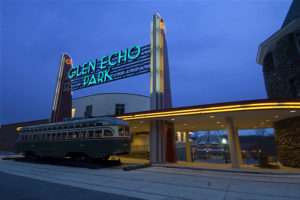
But the park’s future wasn’t as bright. It went out of business in 1968, and the park buildings deteriorated over the years. In recent decades, they have been restored – as has the historic merry-go-round, which was designed by the Dentzel Carousel Co. of Germantown, Pennsylvania.
And now is a great time to visit. The carousel closed for a year for $1 million-plus renovation.
Today park visitors can sit on the same brightly colored animals where protesters made their brave stand. And young visitors can explore the story through the National Park Service’s Junior Ranger handbook.
Baltimore’s segregated carousel
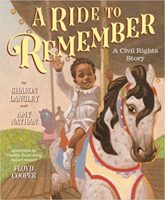
Not surprisingly, other carousels also have similar histories.
Baltimore’s Gwynn Oak Park saw hundreds of people arrested during July 1963 protests that led to the arrests of supportive white Catholic, Protestant and Jewish clergy. The park opened as a whites-only attraction in 1894, and had been the subject of protests for decades.

A month later, on Aug. 28. 1963, the same day as the March on Washington, where Martin Luther King, Jr. delivered his “I have a Dream” speech, the park desegregated.
That morning it welcomed a black child, 11-month old Sharon Langley on the carousel. The infant enjoyed the first ride along with her father, and two white children. One of the other children’s mothers asked Langley’s father to look after her offspring on the ride. It’s a typical requests of a parent, but in the racially charged moment, it took on added significance.
“I think that was an olive branch being extended to my dad, one parent to another,” Langley said in 2020, during webinar discussing a children’s book about the incident.
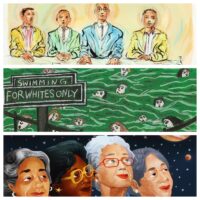 The carousel sit-ins are one of many civil rights topics covered in children’s books. There’s a surprising number of examples, including books devoted to Ruby Bridges, Emmett Till, John Lewis, Malcolm X, Rosa Parks, and many more. Other volumes examine the Greensboro sit-ins, the Birmingham Children’s March, the Loving’s battle for interracial marriage and the Green Book. The carousel sit-ins are one of many civil rights topics covered in children’s books. There’s a surprising number of examples, including books devoted to Ruby Bridges, Emmett Till, John Lewis, Malcolm X, Rosa Parks, and many more. Other volumes examine the Greensboro sit-ins, the Birmingham Children’s March, the Loving’s battle for interracial marriage and the Green Book.
Here’s a comprehensive list from Atlanta’s High Museum of Art.
|
The story also inspired a scene in the film Hairspray, when protesters descended on a fictional Titled Acres park. The original Gwynn Oak has since closed, and is now a Baltimore city park and picnic area.
As for the carousel, it now sits on the National Mall in downtown Washington, where it welcomes visitors. The ride’s graced with an historic marker, noting its significance in the civil rights movement. And the horse Langley rode is named Freedom Rider, and marked with a plaque.
Guidebook
Find information about visiting Glen Echo park here.
For info on riding the former Gwynn Oak carousel on the National Mall, click here.
Find info on other Washington, D.C. metro area sites here.
Two books explore this little-known Gwynn Oak story: the children’s picture book, A Ride to Remember: A Civil Rights Story, and a more detailed examination, Round and Round Together.
Tours
Take a fascinating self-guided Civil War to Civil Rights walking tour, offered by Cultural Tourism DC. Download a free map and guide book here.
Or take a guided tour covering the city’s rich African-American history, including the King Memorial and a reserved ticketed entry to the National Museum of African American History and Culture.
Other cool Washington D.C. tours, including spy tours, Segway tours, night-time bicycle tours, trolley tours, and much more
Dining
For a signature Washington experience, head to Ben’s Chili Bowl. Open since 1958, it has been visited by pretty much every important DC visitor and resident ever since. Don’t expect anything fancy though. The menu’s mainstay are chili dogs, and an only-in-DC sausage called a half-smoke. Also salads and even vegetarian options.
Celebrity chef Jose Andres has several great downtown restaurants, including China Chilicano, Jaleo and Oyamel Cocina Mexicana
For more choices, you’ll find a world of options on Washingtonian magazine’s Top 100 list.
Hotels
Looking for a Washington area hotel?
Willard InterContinental Washington No other D.C. hotel feels more at the center of power than the Willard, a beautiful Beaux Arts building, just a block from the White House. Look for specials or packages because it’s quite spendy.
For something more funky and stylish, consider the stylish Kimpton Hotel Monaco Washington, DC.
If there’s not a convention in town, you often can catch a deal at the Residence Inn or Courtyard by Marriott, which share a lobby, and are walking distance to the Mall.


